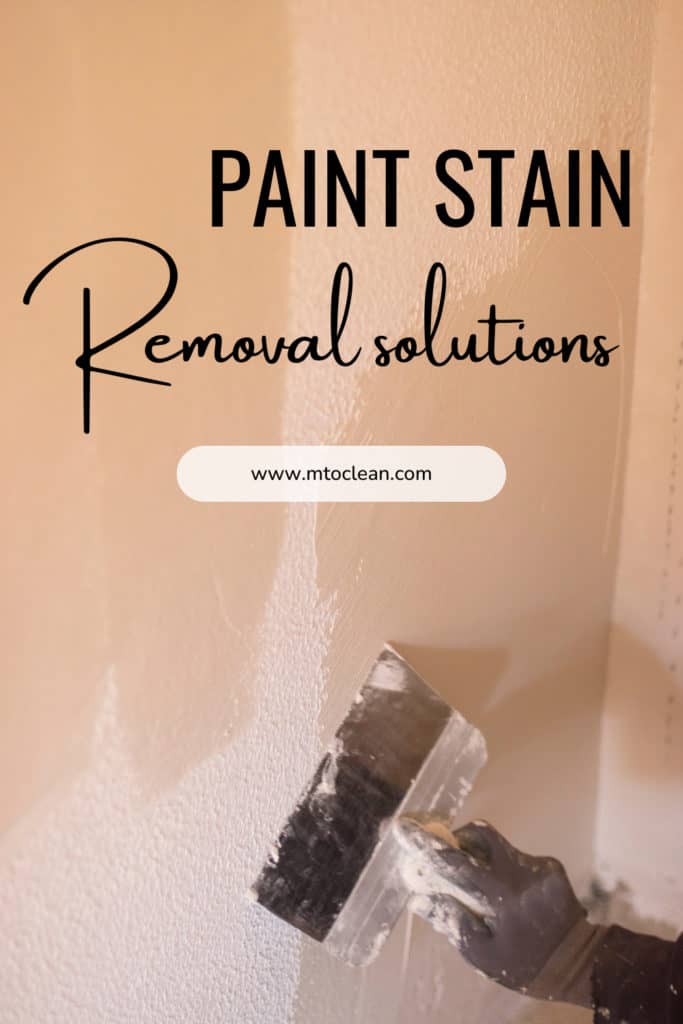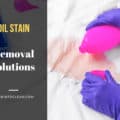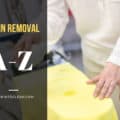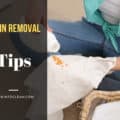Painting your house isn’t exactly a walk in the park, but if you get paint stains on your clothes or carpet, an afternoon of home improvement can turn into a real mess. The first step to knowing how to treat the paint is knowing if it’s water-based or oil-based paint.
The easiest way to find out about this is to read the label on the paint can. Look for the clean-up instructions. If it’s water-based, the directions for clean-up will include instructions for using soap and warm water. If it’s oil-based, the directions will tell you to turn to paint thinner or mineral spirits. This information is key to knowing how to remove those drops (or maybe even a big slosh) of paint.

Acrylic or Water-Based Paint Stains
A substance composed of solid coloring matter suspended in a liquid medium and applied as a protective or decorative coating to various surfaces, or to canvas or other materials in producing a work of art. Acrylic paints and other water-based paints dissolve in water (rather than oil, as in oil-based paints), which makes them a favorite for parents and teachers when painting with children.
Nearly everyone remembers art classes from grade school, with or without fondness. Below are solutions on how to remove water-based paint stains from clothes & fabrics and removing water-based paint stains from carpets & upholstery.
Painting the house is generally a spring and summer activity, so paint stain removal will generally happen in those seasons. Artwork, however, knows no season, and stains that arise during this endeavor can happen at any time of year. You should wear protective or old clothing no matter the type of painting, but there is still a chance that a stain will appear unexpectedly.
See also:
Water-Based Paint Stain Removal from Clothes & Fabrics
Solution 1:
For fresh paint stain removal on fabric:
1. Use a dull knife or spoon to remove as much as possible.
2. Blot stain with an absorbent cloth. Keep the stain moist for best results.
3. Sponge the stain with a sudsy detergent mixture and rinse. Rub the stain between your thumbs.
4. Rinse well.
5. Repeat steps 3 and 4 until you have removed as much stain as possible.
6. If the spot remains, remove paint stain by blotting with nail polish remover on an absorbent cloth.
7. Rinse well.
Solution 2:
For dried paint stain removal on fabric:
1. Brush off as much paint as possible.
2. Apply soapy water or an acrylic paint and varnish remover.
3. Once the stain has softened, use a dull knife or spoon to remove as much as possible. Test first for colorfastness.
4. Rinse well.
5. See steps 2 to 7 for fresh stains, above.
Water-Based Paint Stain Removal from Carpets & Upholstery
Solution 1:
1. Use a dull knife or spoon to remove as much as possible.
2. Blot stain with an absorbent cloth. Keep the stain moist for best results. If paint has already dried, brush off as much as possible, then apply soapy water or an acrylic paint and varnish remover. Once the stain has softened, use a dull knife or spoon to remove as much as possible. Test first for colorfastness. For large spills, saturate the stain with water and lay towels and other absorbent cloths over the area to blot. Walk on the towels to help absorb as much paint as possible.
3. Rinse well.
4. Blot the stain with rubbing alcohol.
5. Rinse well.
6. Repeat steps 2 through 5 until you have removed as much of the stain as possible.
7. If the spot remains, dampen sponge and apply a laundry presoak (spot stain remover) to remove paint stains. Let stand several minutes.
8. Rinse Well.
Solution 2:
Apply turpentine, soap and water. If paint has hardened, soften with paint remover, scrape, and then apply turpentine. Don’t use liquid paint remover if stain is wet.
Oil-Based Paint Stains
A paint in which the colors are suspended in oil, such as linseed oil, which hardens on exposure to the air. Many a cleanup in the studio has lead to slippery, oily messes because oil paint is difficult to clean. It also lasts longer; the paintings passed down from the great masters were painted with oil-based paints. Below are solutions on how to remove oil-based paint stains from clothes & fabrics and removing oil-based paint stains from carpets & upholstery.
Literally any spot on a painter’s body is vulnerable to this stain, from the top of a beret to the bottom of a shoe, and anywhere in between. Artists are forced to act when the muse strikes, therefore the time of a stain’s occurrence is not predictable.
Oil-Based Paint Stain Removal from Clothes & Fabrics
Solution 1:
For fresh paint stain removal on fabric:
1. Use a dull knife or spoon to remove as much as possible.
2. Blot stain with an absorbent cloth. Keep the stain moist for best results.
3. Rinse well.
4. Place fabric stain-side down on an absorbent cloth and sponge the back of the stain with turpentine. Test first for colorfastness. Replace the cloth underneath as it becomes saturated. Continue until no more paint is removed. Do not rinse the stain.
5. Rub liquid laundry detergent into any remaining stain and soak garment in hot water overnight. Occasionally rub the stain between your thumbs during soaking.
6. Rinse well.
7. Launder according to garment label.
8. If the stain remains, apply a laundry presoak (spot stain remover) and let stand several minutes.
9. Launder according to garment label.
Solution 2:
For dried paint stain removal on fabric:
1. Brush off as much as possible.
2. Read the paint can label to obtain a recommended paint-and-varnish remover for thinning the paint, then apply.
3. Once the stain has softened, use a dull knife or spoon to remove as much as possible.
4. Follow steps 2 through 9 for fresh stains, above.
Oil-Based Paint Stain Removal from Carpets & Upholstery
Solution 1:
1. Use a dull knife or spoon to remove as much as possible, then blot stain with an absorbent cloth. Keep the stain moist for best results. If paint has already dried, brush off as much as possible. Read the paint can label to obtain a recommended paint-and-varnish remover for thinning the paint, then apply. Once the stain has softened, use a dull knife or spoon to remove as much as possible. Test first for colorfastness. Rinse well.
2. Blot the stain with turpentine. Test first for colorfastness. Blot repeatedly, alternating turpentine and clean water, until most of the stain is removed.
3. Sponge well with clean water.
4. If the stain remains, sponge with dry-cleaning fluid and blot continuously.
5. Sponge a lukewarm sudsy laundry detergent mixture onto the stain and blot until no more stain can be removed.
6. Sponge well with clean water and let carpet dry thoroughly.
7. Vacuum.
Solution 2:
1. While still wet, emulsion can be rinsed off with water. If dry, break up the paint with the edge of a blunt knife and then vacuum.
2. To remove gloss, use sparing amounts of white spirit but be warned, it can remove color from carpet.
3. When dry, for a superficial stain, try shaving off the paint with a sharp knife – only try it if you are confident of a steady hand, otherwise you may risk holes.
Have you reached paint stain removal success? I hope so!







